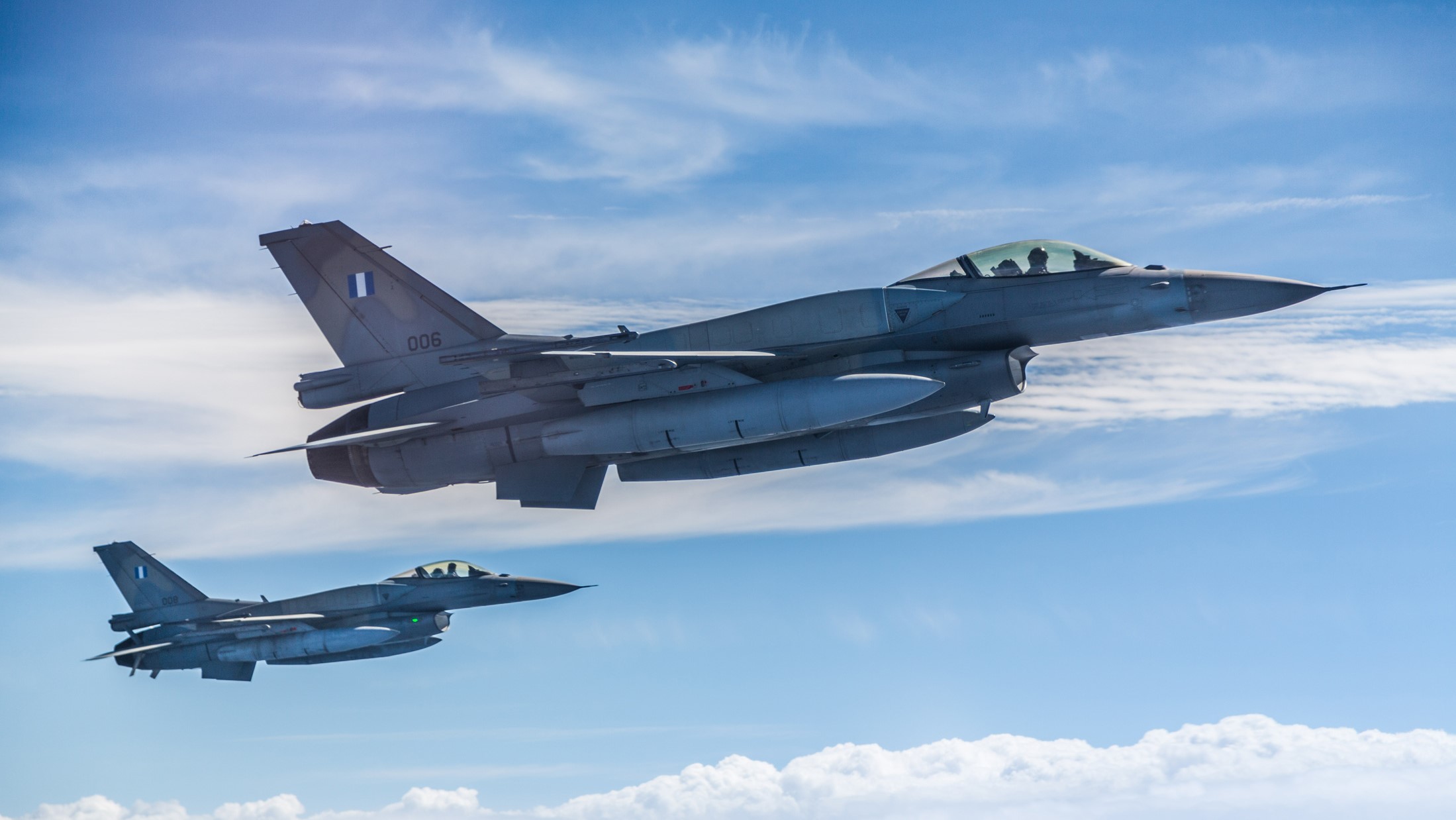
Greek F-16 Flying Falcons take part in a NATO air policing operations in 2018. (NATO)
With Russia continuing to gather on Ukraine’s border and Vladimir Putin making ominous suggestions, the question of how to effectively deter a great power in the modern era feels as pressing as ever. In this analysis, Scott Cooper of the Atlantic Council argues that one solution is to ensure America and its partners’ penetrating air superiority.
Despite generations of distrust between their nations, Chinese President Xi Jinping and Russian President Vladimir Putin last week reaffirmed their commitment to work together to counter “western intrusion” into their affairs. The irony is lost on no one: more than 100,000 Russian troops are now massed along the border with Ukraine, and the threat of Chinese attack on Taiwan is the highest it’s been in decades.
In the international chess match that is Great Power Competition, Xi and Putin appear to be resetting the board from the last time the game was played between East and West. During the Cold War, the US successfully isolated China and the Soviet Union in the 1970s; today, mutual interest appears to be bringing them together.
If the US and its allies plan to credibly deter China or Russia — let alone those two nations operating in closer concert than ever before — all concerned parties need to accept the fundamental truth: real deterrence has to be underpinned by military capability, particularly in the skies.
The last decade has seen three security trends globally; European countries have reduced their defense capabilities; the US has shifted its focus to the Asia-Pacific region; and Russia has improved its military capabilities while demonstrating the political will to use force. In Europe, the US, NATO, and partner countries such as Sweden and Finland have stressed a commitment to defending the Baltic States and Poland. In the Pacific, the US and its partners and allies have opposed any forceful reunification of Taiwan and China.
But unless these claims are backed with credible force, they are certain to be ineffective in preventing conflict. The conversations within NATO of the last decade have stressed the need for every NATO member to spend at least 2% of their respective GDPs on defense. This matters, but just as important is they choose to spend it.
RELATED: Chinese Execute ‘Huge’ Theater Level Exercise; Russia & PRC Start Joint Exercise
The requirement to be able to credibly operate in contested space is the underlying logic of those countries who have chosen to modernize their combat aircraft. Two decades ago, the discussions began seriously about anti-access and area denial, A2/AD, as US China-watchers warned of Beijing’s efforts to prevent the US military from operating in the Western Pacific. The concept has expanded into the strategic debates about the Middle East and Europe. What rests at the core of this is the changed balance of airpower.
The US lost more than 3,300 fixed-wing aircraft in combat during the Vietnam War, largely the work of anti-aircraft artillery and SA-2 missiles provided to North Vietnam by the Soviet Union. In response, the US and allies invested in material solutions and tactics that yielded jaw-dropping results in Operation Desert Storm in 1991. The allies achieved air superiority while losing only 23 aircraft over the course of the 40-day campaign.
But today, the Russian S-300 and S-400 surface-to-air missile systems, with ranges into the hundreds of miles, have ushered in a new reality. Lacking stealth, the West’s legacy fighter and bomber aircraft simply are not survivable against the S-300 and S-400. Further, Russia has sold these missiles all around the world – but especially to China, where these capabilities now form a key part of Beijing’s pursuits to prevent the US military from operating in the Western Pacific.
Today, the European NATO combat aircraft fleet consists of 1,781 aircraft, more than half of which are F-16s or Eurofighter Typhoons. Neither of those aircraft possess stealth, and both are vulnerable to the S-300 and S-400 missiles.
Fortunately, current plans will see European allies field 552 F-35 aircraft. Such capability adds a significant dose of credibility to NATO statements that it can repay Russian aggression in Ukraine with severe costs. The same holds for the US and its allies and partners in the Pacific against China.
That capability got a boost just one week prior to Xi and Putin’s meeting, when Finland announced its selection of the F-35 to replace its aging inventory of F/A-18 Hornets, making the Nordic republic the fourteenth country to procure the fighter.
The decision bolsters the capability of a significantly pro-Western partner in the Nordic-Baltic region: while not a NATO ally, Finland nevertheless meaningfully contributes to deterring Russia. The acquisition of a fifth-generation aircraft capable of operating in contested space also significantly expands the reach of the US and the alliance.
We are back in the world of defense scholar Thomas Schelling, who wrote 55 years ago that “the power to hurt is bargaining power. To exploit it is diplomacy, vicious diplomacy, but diplomacy.” America and her allies should embrace Schelling’s sage wisdom and recognize that military deterrence is a more important tool than it has been since the Cold War.
Scott Cooper is a retired Marine who flew the EA-6B Prowler. He is a senior nonresident fellow at the Atlantic Council and the author of the book “No Fly Zones and International Security” published in 2019.
From F-16s to NATO, Argentina’s moves tilt West, but ties to China to last
There are flashpoints to watch as Argentina navigates its future between the polar attractions of Washington and Beijing, including future defense deals and a deep space facility.


























